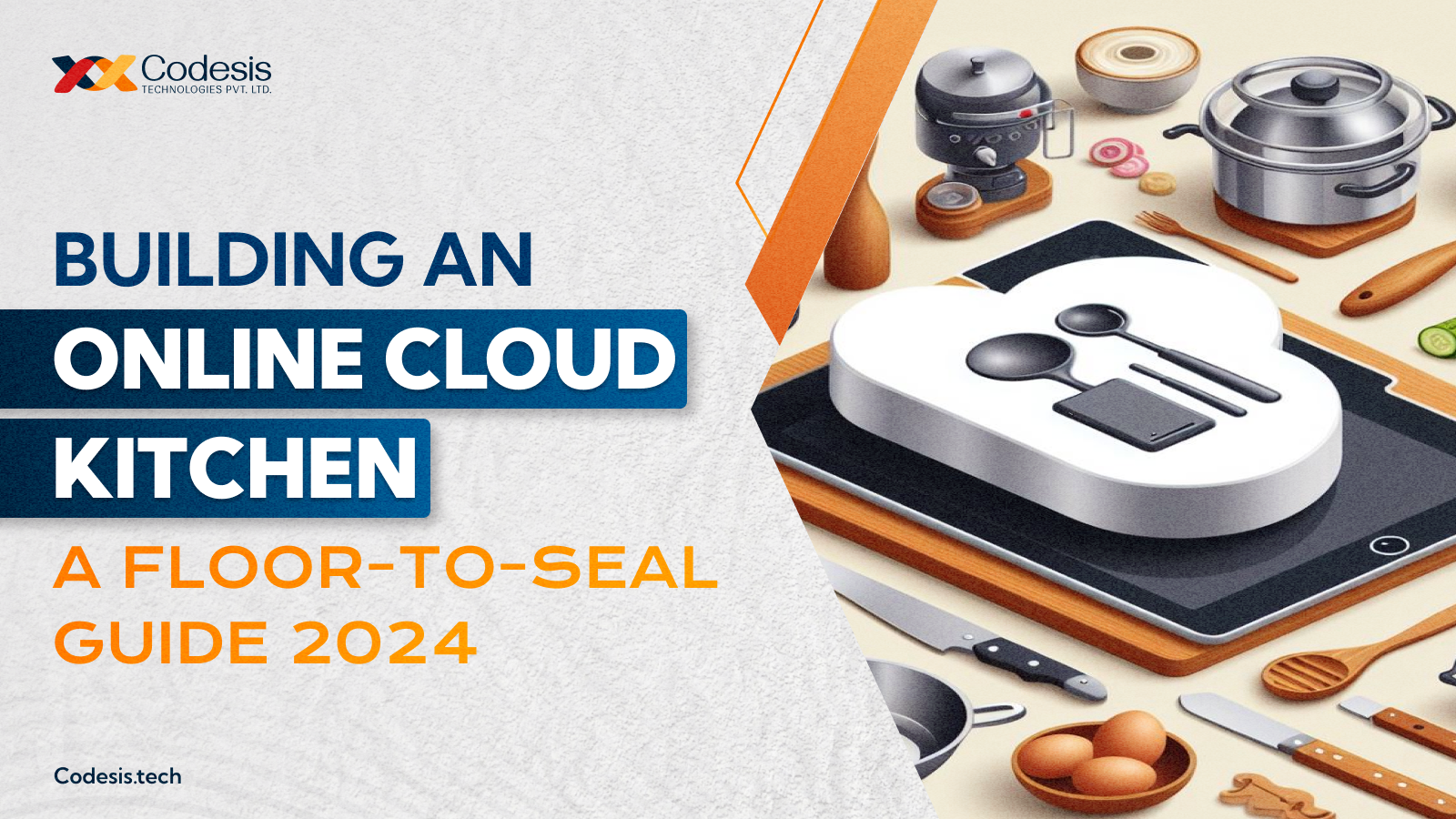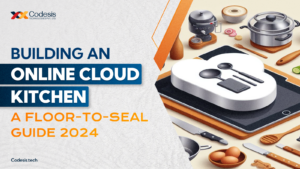The Ultimate AI Skills Every Developer Needs in 2024 Scroll...
Read MoreBuilding An Online Cloud Kitchen: A Floor-To-Seal Guide 2024
Scroll Down
to Read

Introduction
With the growing demand and popularity of cloud platforms, the food and restaurant industry is undergoing digital transformation to the cloud kitchen. The preference for online food delivery services has been gaining popularity at a tremendous rate. In 2022, the global market value of online food delivery services was calculated at $128.32 billion and is expected to grow to $159.46 billion by 2027.
Moreover, with an increase in the use of smartphones and easy access to the internet, the new generation seeks a convenient lifestyle. These factors resulted in the growth and demand for facilities like cloud kitchens or ghost kitchens. According to Research And Markets’ Cloud Kitchen Market report, the global market value of cloud kitchens stood at US$ 63.9 Billion in 2022.
The Russia-Ukraine war:
at least in the short to medium term, impacted global economic recovery from the COVID-19 epidemic. The conflict between these two countries has resulted in economic sanctions against several countries, a rise in commodity prices, and supply chain disruptions, resulting in inflation across goods and services and hurting numerous markets throughout the world. While the market value for the same is projected at $125.5 billion by the year 2028. This means the cloud kitchen market is expected to grow at a CAGR of 11.91% from 2022 to 2028.
As a result, many restaurants and diners are expressing a shift from their traditional dine-in facility to a cloud-based delivery-only service.
Several cloud kitchen startups are emerging to tap into this new, promising, and highly scalable F&B market. However, you’ll need to consider the type of business model, and adhere to certain guidelines, and prerequisites to build a successful online cloud kitchen. But before that let’s take a look at cloud kitchen meaning.
What is Cloud Kitchen?
Cloud Kitchen, also known as Ghost Kitchen, Virtual Kitchen, Home Kitchen or Dark Kitchen, is shaping the restaurant industry with its new format. A Cloud Kitchen is a restaurant that delivers food or allows takeout and does not offer traditional dine-in facilities. They accept orders via their website, app, or various food delivery platforms.
Due to their no-dine-in features, existing restaurants can be easily transformed into cloud kitchens with minimum or zero cost. Many people are turning to cloud kitchens to take advantage of their scalable possibilities and experimental spaces.
Another appealing fact about cloud kitchens is that more than one restaurant brand can operate under the same roof. For example, a multi-brand cloud kitchen allows an Indian-food restaurant owner to run another restaurant from the same establishment.
How does a cloud kitchen work?
A cloud kitchen generates its revenue in a similar way to traditional restaurants i.e. by selling food. The main difference lies in their operating procedure.
Based on a delivery-only format, cloud kitchens solely rely on online orders placed via their websites, apps, and other delivery platforms. Due to this reason, the cloud kitchen concept is considered effortless by most. The Cloud Kitchen also take orders from offline customers only for take-away
Generally, most cloud kitchens use Point-of-sale (POS) software to manage their virtual kitchen, accept orders, and process deliveries. For multi-brand cloud kitchens, the POS software is integrated with third-party food aggregators to process and analyze orders in bulk quantity.
The POS system notifies the specific kitchen based on the order details. It also updates the order status by notifying the customers and assigning delivery agents, making operations efficient and seamless.
Types of cloud kitchen business models
The main objective of every cloud kitchen is the same, to deliver food ordered online. However, there is a difference in how these processes are executed. Based on the type of execution, cloud kitchens can be divided into several business models.
Standalone Ghost Kitchen or Dark Kitchen
These are commercial kitchens owned by a single restaurant. The restaurant owner is responsible for providing kitchen equipment, staff, delivery, and marketing.
A standalone kitchen generally specializes in one or two cuisines and has fewer items on its menu. Therefore, standalone kitchens have a small workstation, generally an average of 300 square feet.
Most of the time, standalone kitchens rely on third-party food delivery platforms for operation.
Multi-brand Kitchen or Co-Working Cloud Kitchen
The flexibility of a cloud kitchen business model allows its owners to facilitate more than one restaurant under its roof.
A multi-brand cloud kitchen opens opportunities for business expansion by facilitating restaurants specializing in different types of cuisines. Thus attending to a wide range of customers.
Their kitchen workspace is comparatively larger than standalone cloud kitchens.
Example – Curefoods, a cloud kitchen startup in Bangalore.
Virtual Restaurants
These type of restaurants exists only in the virtual world. They develop brands and menus by analyzing data and studying local demand.
Although they utilize an existing restaurant to carry out their operations, virtual restaurants provide a completely different menu from the existing restaurant. As a result, virtual restaurants are a great way to experiment with new dishes and ideas.
Example – Canada-based cloud kitchen operator, JustKitchen has signed a royalty-based agreement with an Indian company to provide virtual kitchen services.
Kitchen as a Service (KaaS)
The name speaks for itself, Kitchen as a Service are cloud kitchen offering small restaurants with kitchen equipment and a chef crew. They prepare food for other restaurants and brands while the businesses oversee marketing, sales, and delivery.
Example – RestoLabs
Hub and Spoke
A Hub and Spoke cloud kitchen is a central kitchen that prepares the food partially cooked. It is then shipped to outlets for their final touch before sending it out for delivery.
The Hub and Spoke cloud kitchen business model can be categorized into two owned or hosted cloud kitchens(KaaS).
Example- JustKitchen
Aggregator Managed Cloud Kitchen
Food aggregators manage large coworking kitchens referred to as aggregator cloud kitchens. They provide empty kitchen spaces for restaurants to rent. The food prepared in these restaurants can be ordered only from these restaurants.
The most popular examples of food aggregators in India are Zomato, Swiggy and Magicpin.
How to start a cloud kitchen?
1. Location
Like in traditional restaurants, location is also an important factor for cloud kitchens. In cloud kitchens, location doesn’t play any role in governing footfalls, parking spaces, or high-end sites. However, the location of the property plays a significant role in proper sanitation and water supply, as well as affordable rent.
Cloud kitchens can operate from any location or type of property. Since cloud kitchens don’t require big square feet of space to operate, they can be easily set up anywhere. Residential locations, market backsides, and unused parking spaces are some of the preferred locations for setting up a cloud kitchen.
For example, Si-Pie Pizzeria’s owner Simon Mikhail opened a ghost kitchen selling chicken after being notified by UberEats about a high demand for chicken in his neighborhood.
Another important thing to keep in mind is that cloud kitchens should be situated in areas with high food demand. You need to select a location that is appropriate for your customer demographic and type of food product.
2. License
In the F&B business, maintaining proper sanitation and hygiene is a must. Thus, you need to acquire the appropriate license and certification, to begin with.
Since customers can’t visit your restaurant directly to check the hygiene and food safety standards. Having the proper licenses and certifications will give them a sense of satisfaction. Moreover, it will save you from any kind of hassles in the future.
Some of the basic licenses that you need to start a cloud kitchen in India are FSSAI, GST Registration, NOC from the fire department, and Municipal health trade license. Although GST is optional for the cloud kitchen turnover of less than 20 lakh rupees in a year.
It is advised to go through proper channels or hire an agency since acquiring these licenses and permits is a very tedious and time-consuming process.
3. Kitchen Equipment
Kitchen setup costs can vary depending on your business model and the type of cuisines you are offering. However, you do need basic equipment like a stove, oven, refrigerator, chimneys, and other basic kitchen tools.
Frugal spending can help you save a lot of expenses by dividing kitchen equipment and tools based on their usage. For example purchasing refrigerators, ovens, chimneys, and other electronic items in new condition. Whereas procuring old kitchen tools such as containers, cutting tools, etc.
Since you are no longer able to serve or interact with your customers physically. It is important to divert that focus to premium quality packaging with your brand logo or name to leave a good impression and create brand awareness.
4. Kitchen Crew and Staff
Your cloud kitchen is as good as the crew you hired. Getting a good chef on the team is essential since they are not only responsible for the food you serve but also for creating the menu.
Since there is no dine-in facility in cloud kitchens, you can set up shop by hiring fewer people. According to norms, a basic cloud kitchen setup requires a minimum number of five people including at least two chefs, two helpers, and a housekeeper.
5. Technology
Cloud kitchens are often referred to as the tech startups of the F&B sector. The whole concept of a cloud kitchen revolves around technology which is why you need to be equipped with the best technology.
These are some of the must-have technologies to start a cloud kitchen.
- POS System:
A cloud kitchen can receive a large number of orders from various channels. To effectively handle incoming orders without any discrepancies you’ll need to have a Point-Of-Sale (POS) System.
A POS system efficiently accepts and collects orders from various channels and even manages the delivery process.
Moreover, it also helps in collecting data from customers which helps in studying the market preferences and enhancing personalization.
For example: Petpooja, Zakya, and Gofrugal are a few of the famous POS systems used by Cloud restaurant owners.
- Online Platform:
A cloud kitchen without an online presence is just a brick-and-mortar store with kitchen equipment. An online platform not only helps in receiving orders but also creates a brand presence and aids customers in interacting with the brand.
There are three ways a customer can interact with a cloud kitchen:
- Website
- Mobile Application
- Integrating with food delivery apps
Third-Party Integration:
Integration with third-party food aggregators automatically raises the level of cloud kitchen startups. Enlisting on renowned platforms like Zomato, Swiggy, and magicpin makes your brand discoverable to potential customers.
Furthermore, these brands already have an existing order-receiving and delivering mechanism. This saves you from the hassles of managing orders along with eliminating the expenses of the entire delivery process.
However, you do have to pay a certain percentage of your order to these third-party apps. Whereas Zomato and Swiggy charge a percentage between 28-35% and Magicpin charges a percentage between 23-25% per order.
- Integrated Kitchen Display System:
If you have a multi-brand cloud kitchen business model, it is quite normal to receive orders in large volumes. Managing and processing these orders under a given time range can be very challenging. This is where an Integrated Kitchen Display (KDS) System comes into use.
Instead of writing orders on sticky notes, orders are directly displayed on KDS with detailed descriptions including personalization requests by customers. Thus streamlining operations, increasing efficiency, and making it convenient for chefs to optimize prep time.
6. Intense Marketing Strategy
A traditional restaurant is located in high foot-traffic areas with display boards and signs creating a brand recall and increasing visibility. A cloud kitchen lacks this opportunity due to its no dine-in facility, thus, relying completely on online marketing such as:
Social media marketing: Creating social media pages and posting enticing pictures is crucial in achieving brand visibility and redirecting viewers to your website or app.
Loyalty Programs, SMS and email campaigns: Loyalty programs like collecting and redeeming points help in retaining existing customers. Moreover, by collecting data you can send personalized SMS and email campaigns to specific customers which in turn increases ROI.
Promoting your brand on online food aggregators: Listing and promoting your business on a renowned food aggregator’s platform increases your visibility and brings potential customers from day 1. You can run ads on the food aggregators apps like zomato, swiggy and Magicpin through the restaurant dashboard they provide.
- Running Google ads and Facebook ads: Running targeted ads on Facebook and Google on a particular location around the restaurant can be very beneficial to the restaurant. One can make a poster or flyer on editing software like Canva and can use the same flyer in Facebook and Google ads to attract more customers and increase sales.
Benefits of starting a Cloud Kitchen
Cost-effective: Cloud kitchens are very light on your pocket since they require very little investment and low operational costs compared to a traditional restaurant. Moreover, the no dine-in feature reduces the workforce required to operate the business.
Scalability: Cloud Kitchen allows you to expand your market as per your preference, without adding overhead costs or planning.
Personalization: Since your business is web-based or app-based, you can customize your menu according to the demographics of market data of your location.
High-Profit Margin: Compared to traditional restaurants, Cloud Kitchen has relatively low overhead costs, low labour costs, and a low level of maintenance, which leads to a very high-profit margin. Moreover, using high-end software makes operations seamless and efficient reducing errors.
In light of the rapid growth of the restaurant industry, cloud kitchens seem like the logical next step. With the dominance of online food aggregators like Zomato, Swiggy, Magicpin and others, we believe that the cloud kitchen business will soon dominate the F&B industry.
Despite cloud kitchen formats being one of the most profitable restaurant formats, with the least amount of risk, you still have to stay on your toes. Follow our guidelines to grow your cloud kitchen business and get maximum returns from your investment.
In conclusion, the rise of online cloud kitchens is changing how we get our food, responding to the growing demand for smooth and brief food delivery. This guide talks about different forms of cloud kitchens and how important technology and good marketing are for them to be successful in this industry. Cloud kitchens, which can be single or offer multiple brands, are a smart choice for businesses due to their lower costs, capacity to grow, and personalized approach.
Get in touch with us at [email protected]
Please visit our other blogs by clicking here.
Building An Online Cloud Kitchen: A Floor-To-Seal Guide 2024
Building An Online Cloud Kitchen: A Floor-To-Seal Guide 2024 Scroll...
Read More7 Game-Changing Benefits of Custom Software Development
7 Game-Changing Benefits of Custom Software Development Scroll Down to...
Read MoreThe Ultimate Guide to Recruiting Full-Stack Developers for Your Web Project
The Ultimate Guide to Recruiting Full-Stack Developers for Your Web...
Read More

